 advertisements advertisements
|

|
Ken Mattingly, who launched to the moon on Apollo 16, dies at 87
November 2, 2023 — For the record, Ken Mattingly never did get the German measles.
The former NASA astronaut, who in 1970 was pulled from the Apollo 13 crew due to being exposed to the Rubella virus, died on Tuesday (Oct. 31) at the age of 87. Mattingly's death was confirmed by NASA.
"NASA astronaut TK Mattingly was key to the success of our Apollo Program, and his shining personality will ensure he is remembered throughout history," NASA Administrator Bill Nelson said in a statement released Thursday. "As a leader in exploratory missions, TK will be remembered for braving the unknown for the sake of our country's future."
Chosen with NASA's fifth class of astronauts in 1966, Mattingly went on to fly to the moon and then led two space shuttle missions. He logged a total of 21 days, 4 hours and 34 minutes in space, including 1 hour, 23 minutes on a spacewalk near the moon, the second deep space extravehicular activity (EVA) in history.
Mattingly was exposed to the German measles by fellow astronaut — and later Apollo 16 crewmate — Charlie Duke. The only member of the original Apollo 13 crew not to be immune, NASA's flight doctors were concerned Mattingly would fall ill during the mission, leading to the decision he be replaced by his backup, Jack Swigert.
"I'm driving up the road, turned the radio on and they interrupt the news announcement that this afternoon NASA has announced that they have changed and substituted Jack Swigert for me," said Mattingly, recalling how he first learned of his being grounded in a 2001 NASA oral history interview. "I just kind of pulled over to the side of the road and sat there for a while."
The swap was made just three days before the launch. When the Apollo 13 crew "had a problem" — an explosion that crippled their spacecraft on the way to the moon — Mattingly joined the team working at Mission Control to bring Jim Lovell, Fred Haise and Swigert home safely.
"Movies and everything makes it look like we invented a lot of stuff. Well, thanks to the kind of simulation training program we had, maybe the things weren't exactly the same or in an exactly the same order, but everything we ended up doing had been done somewhere," said Mattingly.
In hindsight, Mattingly said it was a good thing he did not fly on Apollo 13, but not because he might have developed the measles.
"When my body gets below 60 degrees, it doesn't function," he said. "If I had been stuck up there, I would have absolutely been a disaster. You can go so far on mental activities, but I know me and I know how my body behaves, and it would have shut down. So it would have been more than just unpleasant for me."
Casper, Columbia and Discovery
After Apollo 13, Mattingly was assigned to the crew of Apollo 16, the fifth moon landing mission, with commander John Young and lunar module pilot Duke. As command module pilot, Mattingly remained in lunar orbit while Young and Duke landed on the moon in April 1972.
For 3 days, 9 hours, 27 minutes (and 47 seconds), Mattingly circled the moon alone aboard the command module "Casper," while photographing and mapping the lunar surface, as well as conducting more than 20 science experiments.
"I spent a lot of time trying to look at [the surface on the near and far sides of the moon] to see what could you see that was different or alike. It gave a fascinating problem in trying to see — I know it looks different on the back than it does on the front," Mattingly said. "Back side of the moon, it looks like a kid's sandbox. It's really pummeled. Whereas the front side of the moon has features that look sharp and they look like mountains, they look like craters, there's something to look at everywhere."
After being reunited with Young and Duke and the three departing the moon for Earth, Mattingly conducted the second-ever deep space EVA to retrieve the film from cameras mounted on Casper's service module and to conduct two science experiments.
"Well, prior to opening the [hatch] — well, somewhere, I don't know where in the mission, I lost my wedding ring. It came off, and I couldn't find it. Normally I found I could find things after a long period of time, they'd collect on the air filters, but it never showed up. I had given up and said, 'Well, guess I lost it,'" said Mattingly.
"So, I started to go back to the service module when Charlie said, 'Look at that.' And there was my wedding ring floating out the door. I grabbed it and we put it in the pocket," Mattingly said. "We had the chances of a gazillion to one."
Apollo 16 splashed down in the South Pacific Ocean on April 27, 1972. Mattingly's next flight launched 10 years and 2 months later on June 27, 1982.
STS-4 was the fourth flight of the space shuttle program, fourth flight of the orbiter Columbia and the final test flight for the winged spacecraft. Mattingly commanded the week-long mission with Henry "Hank" Hartsfield serving as pilot.
"They got [us] on orbit, and this thing worked, and I just couldn't get over the fact that after — you know, people that I knew that were friends had built and conceived this whole thing, and it works. It's just magic. It does all of these things that we dreamed of, but the visuals are better than the simulator now. So we just had a wonderful time of it," said Mattingly, telling the NASA interviewer about how Columbia performed.
"Flying around Earth is just so spectacular," he said. "I don't care how long you're up there, I can't imagine anyone ever getting tired of it. It's just beautiful, and the orbiter with these big windows, it is just wonderful."
Mattingly was at the shuttle's controls when he brought Columbia back to Earth to an Independence Day landing at Edwards Air Force Base in California. President Ronald Reagan was waiting there to welcome him and Hartsfield home.
"It was no uncertain terms that we were going to land on the Fourth of July, no matter what day we took off. Even if it was the fifth, we were going to land on the Fourth," Mattingly said with a laugh. "That meant, if you didn't do any of your test mission, that's okay, as long as you just land on the Fourth, because the president is going to be there. We thought that was kind of interesting."
Mattingly's third and last spaceflight was as commander of the STS-51C crew on space shuttle Discovery. The first mission dedicated to deploying a Department of Defense payload, many of the details of the flight remain classified today.
Lifting off on Jan. 24, 1985, Mattingly's crew included pilot Loren Shriver, mission specialists Ellison Onizuka and Jim Buchli and payload specialist Gary Payton. The three-day flight was the 100th crewed mission to reach orbit.
"I still can't talk about what the mission [was]," said Mattingly in 2001. "When the books are written and somebody finally comes out and tells that chapter, everybody is going to be proud."
Mattingly landed Discovery on Jan. 27, 1985, one day shy of a year before the space shuttle Challenger broke apart 73 seconds into its launch. A later investigation found that STS-51C had suffered the same issue with its solid rocket boosters that led to the Challenger tragedy.
TK
Thomas Kenneth "TK" Mattingly II was born on March 17, 1936, in Chicago, Illinois. He earned his Bachelor of Science degree in aeronautical engineering from Auburn University in 1958 and then enlisted in the U.S. Navy, earning his wings in 1960.
Mattingly flew A1H aircraft with the VA-35 squadron from the USS Saratoga aircraft carrier from 1960 to 1963 and A3B craft with the VAH-11 from the USS Franklin D. Roosevelt from 1964 to 1966. He was a student at the Air Force Aerospace Research Pilot School at Edwards Air Force Base when he was selected as one of NASA's 19 new astronauts in April 1966.
Prior to being assigned to the Apollo 13 prime crew, Mattingly was a member of the support crew for Apollo 8, serving as a capcom in Mission Control. He was then assigned to backup the command module pilot for Apollo 11, the first moon landing mission.
Between his flights on Apollo 16 and STS-4, Mattingly served in astronaut managerial positions in the space shuttle development program. After landing on STS-51C, Mattingly decided to retire from NASA and return to the Navy.
"I was ready to move on to something else. The only mission that I really thought I could get interested in was the first [space shuttle mission to launch from] Vandenberg [Air Force Base, California], and Crip [Bob Crippen] was already doing that, and so I decided it was probably best to change assignments."
Mattingly remained with the Navy for one more year, retiring with the two-star rank of rear admiral, before entering the aerospace industry. He worked as a director in Grumman's [today, Northrop Grumman] Space Station Support Division before joining Lockheed Martin, where he was vice president in charge of the company's X-33 spaceplane development program. He completed his career at Systems Planning and Analysis in Virginia.
For his service to the U.S. space program, Mattingly was awarded the NASA Distinguished Service Medal, the NASA Space Flight Medal, U.S. Navy Astronaut Wings and the Society of Experimental Test Pilots' Ivan C. Kincheloe Award, among other honors.
Mattingly was inducted into the International Space Hall of Fame in 1983 and the U.S. Astronaut Hall of Fame in 1997. In 2009, he accepted NASA's Ambassador of Exploration award and presented the moon rock-adorned trophy for display at Auburn University, his alma mater.
In 1995, Mattingly was portrayed by actor Gary Sinise in the feature film "Apollo 13." Three years later, actor Željko Ivanek played him in the HBO miniseries "From the Earth to the Moon."
Mattingly married Elizabeth Dailey in 1970, and together they had a son, Thomas Kenneth Mattingly III, born in 1972. The two were separated before Dailey died in 1991. |
|
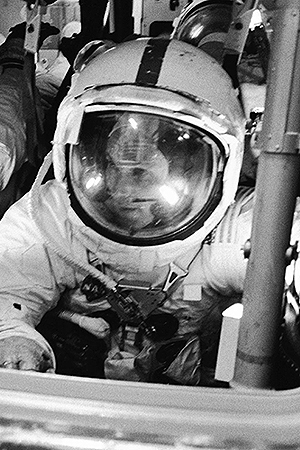
Ken Mattingly, command module pilot on Apollo 16, participates in extravehicular activity (EVA), or spacewalk, training at the Manned Spacecraft Center (today, Johnson Space Center) in 1972. (NASA)
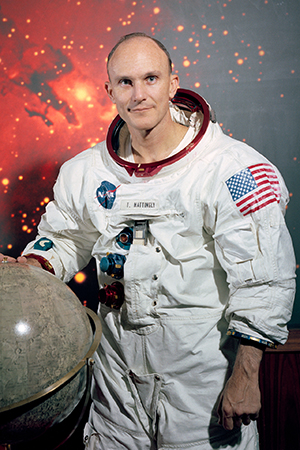
Ken Mattingly's official NASA portrait as a member of the Apollo 13 crew. Mattingly was pulled from the mission after being exposed to the Rubella virus (German measles) in April 1970. (NASA)
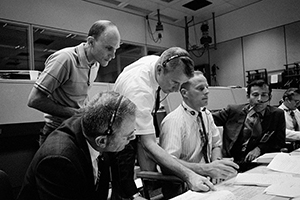
Ken Mattingly (second from left, standing) in Mission Control after the mid-flight explosion aboard Apollo 13 in April 1970. (NASA)
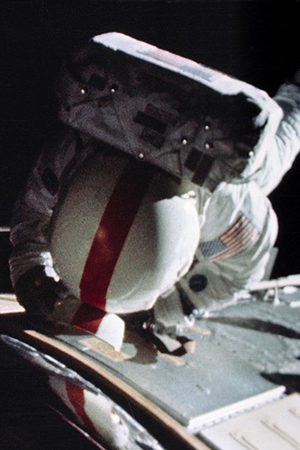
Ken Mattingly performs a deep space extravehicular activity (EVA), or spacewalk, outside of the Apollo 16 spacecraft in 1972. (NASA)
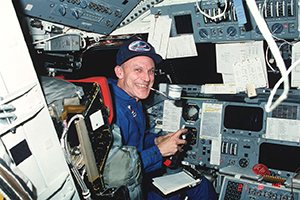
Ken Mattingly at the commander's station aboard the space shuttle Columbia during the STS-4 mission in June 1982. (NASA)
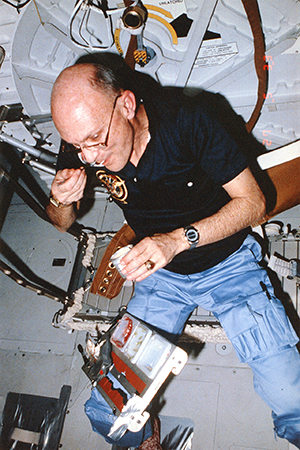
STS-51C mission commander Ken Mattingly enjoys a meal on the mid-deck of space shuttle Discovery in January 1985. (NASA) |
|

© collectSPACE. All rights reserved.
|
|

|

|
